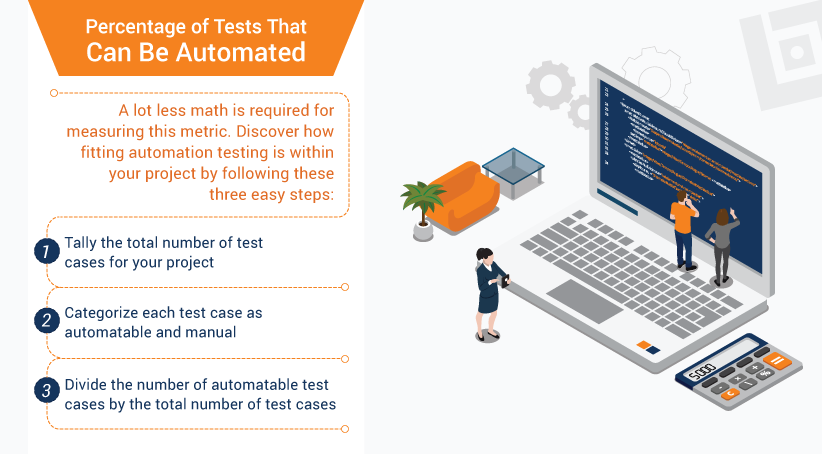
While automation testing can help streamline your agile development process, it's not a quick fix solution. Truth is, automation testing can work against your best efforts if implemented incorrectly or executed poorly. Since automated testing can be a significant investment for organizations of every size, a confirmation that your team’s resources are allocated appropriately for every stage of every project can go a long way.
Is there a clear way to see if automation testing is working for (or against) you?
Yes, and it’s all about the numbers. QA teams that regularly collect automation testing metrics can gauge their level of success project after project as well as strategize on ways to improve their practices and alter tactics before the next release cycle begins.
Before transitioning to automation testing, determine which stats are right for you to monitor regularly. We recommend incorporating the following automation testing metrics into your status reports.
Break-even Analysis for Automation
Automation testing intends to increase team productivity, yet some automated tests fail to deliver on that expectation. A break-even analysis can determine where automated tests fall short so that your project can deliver a positive return on investment (ROI).
You can measure your ROI by monitoring the data for these automation testing metrics:
- Development Time (DT): How many hours does it take to develop and push an automated test?
- Upkeep Time (UT): How many hours does it take to apply infrastructure changes, complete enhancement requests and fix bugs?
- Manual Test Time (MT): How many hours does it take to complete a manual test?
- Automated Working time (AT): How many hours does it take to complete a task using automation?
- Cases Count (CC): How many test cases need to be executed?
Now for some insightful equations:
- Project Overhead = DT + UT
- Savings from Automation Testing = (MT – AT) x CC
- ROI = Savings from Automation Testing - Project Overhead
Percentage of Tests That Can Be Automated
The calculated answer to this division problem is also known as the Automation Index of your project. By adding this measurement to your automation testing metrics report, your team gains visibility on what resources are needed to complete this project successfully, whether it be more time and testing environments or ongoing QA support.
Keep in mind that some automatable tests may require additional manual testing in order to validate a pass or fail status. You can still include these test cases within your total automated case studies as long as you have a plan in place to also revisit these test cases manually during the testing process.
Automated Suite Execution Time vs Manual Execution Time
Despite the advancement of technology and automation, there is always a need for manual testing within the development cycle. Some tests require a human perspective that automated testing cannot provide, be it user experience testing or exploratory testing. And let’s not forget how manual testers can emotionally empathize with the targeted end-user, leading to a more familiar understanding within the QA process.
On the flip side, human testers take more time to complete the project’s manual tests. Because automated testing is designed to increase the project’s speed and test coverage while reducing costs, it’s easy to see why most development cycles incorporate both methods.
What that balance is within your project comes down to your automation testing metrics. First, calculate how much time it takes to execute your automated tests. Next, measure how much time it takes to execute your manual tests. This ratio can reveal additional opportunities to automate tests when saving time is crucial within a release cycle.
Automated Test Coverage
Think of this metric as an indicator of the completeness of your project. By featuring this measurement within your automation testing metrics report, you can reveal how much of the software’s functionality is being covered during the testing process as well as which parts of your software needs more sufficient test coverage. In short, this calculation measures not the effectiveness of automated testing but rather its presence within your project.
This insight can help you reallocate project resources during the QA process in real time. For example, key players on your team can be reassigned to higher priority tasks that may require manual testing if automated testing can cover more ground than expected. This is often where the real value of automated testing lies.
Total Test Duration
Here’s a simple, straightforward measurement to include in your automation testing metrics report. How long does it take for your team to run automated tests? In other words, does the time it takes to run automated tests measure up to Agile and DevOps expectations?
A fast-paced development environment requires automated testing to match the speed of software development. If automated testing continues to bottleneck the development cycle, then your team must strategize ways to optimize these automated tests to streamline the project.
You can be sure that you are measuring the right automation testing metrics when the numbers you collect provide predictive results during future development cycles. If you are still uncertain how to measure success of your automation testing process, consider partnering with a QA services provider like QASource. Our team of automation testing experts are skilled in guiding you through QA testing and pinpointing the right automation testing metrics worth measuring. Learn more or get a free quote today.
Want to learn about other metrics that can help your automation be successful?
Watch our webinar Measuring Your Way to Successful Automation below!






